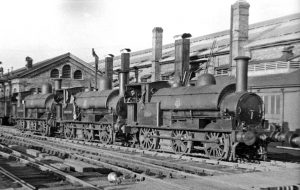Introduction:
Wolverton Works, located in the town of Wolverton, Buckinghamshire, United Kingdom, stands as a testament to the rich history and innovation in railway engineering. With a legacy dating back to the 19th century, Wolverton Works has played a pivotal role in the development of the railway industry, leaving an indelible mark on the landscape of British transportation.
The Early Years of Wolverton Works:
Founded in 1838 by the London and Birmingham Railway Company, Wolverton Works was established to meet the growing demand for maintenance and repair facilities for the burgeoning railway network. Initially, the works focused on locomotive repairs, catering to the steam-powered engines that powered the trains of the time.

Innovation and Expansion:
As the railway industry expanded, Wolverton Works evolved to meet the changing needs of the time. In the mid-19th century, the works became renowned for its innovative approach to engineering. Wolverton was among the first railway workshops to introduce mass production techniques, applying assembly line principles to the manufacturing of railway carriages. This pioneering approach significantly increased efficiency, enabling the rapid production of standardized carriages and fostering the growth of the railway network.
Wolverton Works also earned a reputation for craftsmanship and attention to detail. The works’ skilled workforce was responsible for the construction of luxurious carriages for prestigious trains like the Royal Scot and the Queen of Scots. These finely crafted carriages set a new standard for comfort and luxury in rail travel, catering to the growing demand for high-quality passenger services.
The Role in Wartime:
During both World Wars, Wolverton played a crucial role in supporting the war effort. In World War I, the works contributed to the production of munitions and military equipment. In World War II, Wolverton Works shifted its focus to the repair and maintenance of military vehicles, including tanks and armored cars. The dedication and adaptability of the workforce during these challenging times showcased the resilience and importance of Wolverton Works in times of national need.
Nationalization and Modernization:
In 1948, Wolverton became part of British Railways following the nationalization of the railway industry. The post-war period saw a shift from steam to diesel and electric locomotives, prompting Wolverton to adapt its facilities and expertise. The works became a hub for the modernization of rolling stock, playing a key role in the construction and maintenance of the new generation of trains.
Despite the decline of traditional rail travel in the latter half of the 20th century, Wolverton Works continued to evolve. The works diversified its operations, offering services beyond railway engineering. this included being involved in the refurbishment and modification of various types of rolling stock, ensuring its relevance in the changing landscape of transportation.
Privatization and Contemporary Significance:
With the privatization of the British Railways in the 1990s, Wolverton transitioned to private ownership. The works became part of Knorr-Bremse, a global leader in rail and commercial vehicle systems. This transition allowed Wolverton to tap into international markets and remain at the forefront of technological advancements in rail engineering.
Conclusion:
The Works stands as a living testament to the resilience, innovation, and adaptability of the British railway industry. From its humble beginnings in the 19th century to its role in the modern era of rail transportation, Wolverton has been at the heart of the evolution of the railway landscape. Today, as a part of Knorr-Bremse, Wolverton Works continues to contribute to the advancement of railway technology, ensuring its place in the history and future of British rail engineering.






